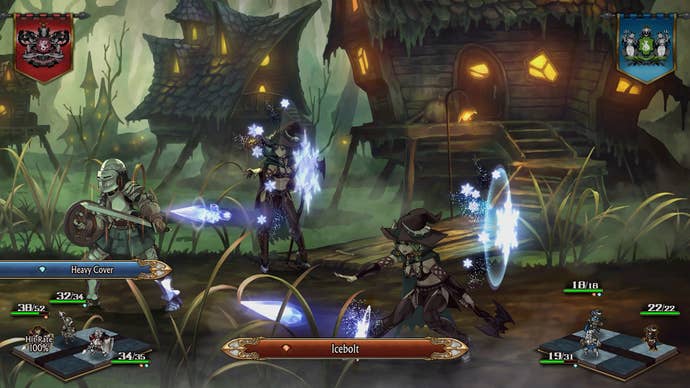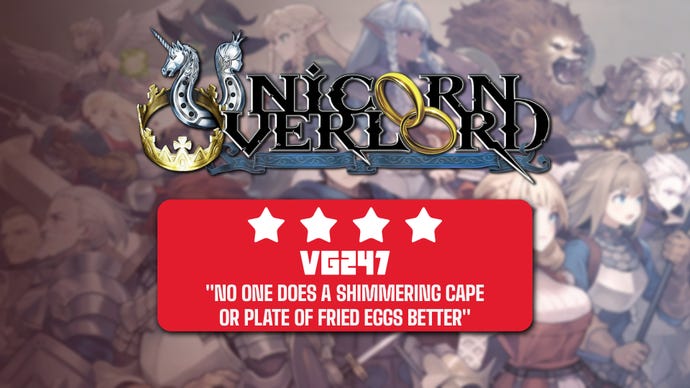Unicorn Overlord review – super soup of strategy and story, swords and sorcery
VanillaWare returns from the success of Aegis Rim: 13 Sentinels to deliver a toybox of action figures, with the strategic depth of chess.
I’ve decided the axe-wielding muscle man and tiny swamp witch are besties. How could you not?
Then, obviously, the two knights who used to be engaged have to go together so we can watch the sparks fly. But when things go wrong I can always count on my Expendables-like supergroup of the baddest mercenaries in the land to come over the hill and save the day – for maximum dramatic effect, of course.
But then Unicorn Overlord is also the story of a revolution, as Price Alain leads his Liberation Army into battle against the evil Zenoiran Empire. Deposed and exiled as a child, but kept safe by his mother’s most trusted royal advisors, Alain travels the four corners of Fevrith, gathering allies and bolstering support for his popular rebellion.
It’s very traditional medieval fantasy, but told in Vanillaware’s truly unique and unmistakable style: a mixture of pulp and pomp that does so much to evoke the spirit of epic adventure by blending ethereal and dreamy atmosphere with hand-drawn environments, heavy breathing, and character designs with one foot in Frank Frazetta and the other in the dark corners of DeviantArt. No one does a shimmering cape or a plateful of fried eggs better.
But it’s not all about distinct visuals. Throughout its back catalogue, Vanillaware has shown an incredible ability to adapt that style to a range of different gameplay genres. But rather than a complete departure from what’s come before, Unicorn Overlord is an iteration and evolution of the marriage of visual novel and RTS we saw in the masterful 13 Sentinels: Aegis Rim.
Within a classically-styled overworld, which calls to mind just about every legendary turn-based RPG you can think of, you bounce from pillar to post liberating towns, raiding forts, and sacking settlements in a series of big battles and smaller skirmishes. You start the game with just a few units of two characters, but can eventually throw together up to six, offering a massive degree of tactical flexibility.
With the huge amount of unit types on offer – from flying wyvern riders that can skim over any terrain, to quick and deadly cavalry and towering defensive hoplites – each scenario plays out a bit like a puzzle. You have to work out how to take over an enemy’s base by spawning the right squads with the resources you have available, matching or counting the classes put out to stop you, without leaving your own home base open to counter attack or your army open to an ambush from reinforcements.
Once you add different special abilities, siege weapons and obstacles into the pot, there’s a compelling number of decisions to make moment-to-moment. But then, as two opposing forces square off, the scene changes from a bird’s eye view to a lavishly animated auto-battle where the match-up resolves. The first time I saw one of these, I said “wow” out loud.
.png?width=690&quality=70&format=jpg&auto=webp)
But while you can hire randomly generated mercenaries, the vast majority of your army is made up of unique, voiced characters with their own quest and place in the overarching story.
This incredible variety is brilliant, adding intriguing narratives to discover in almost every area of the world, as well as immeasurable opportunities to create your own head-cannon friendships, rivalries and romances within the burgeoning militia you control. Many of these are also officially supported by a constantly filling relationship meter, which plays special scenes between characters that forge a bond in the heat of battle. Think Fire Emblem, but more... robust.
However, while the vast roster of heroes is undoubtedly one of Unicorn Overlord’s biggest strengths, it can also be incredibly overwhelming both from a storytelling and gameplay perspective. There are simply so many unique characters that it can be tough to keep track of who’s who, but the main thing is that you’re rewarded for constantly juggling and optimising your unit formations.
Clunking in and out of menus and having to remember who you like on each team and in what position is information overload, as is managing the dizzying array or armour and equipment you need to outfit your soldiers with as the game progresses.
.png?width=690&quality=70&format=jpg&auto=webp)
You can largely muddle through and rely on the same comfortable combinations of characters you like together, but once it clicks how much you can affect the outcome of individual skirmishes by rejigging the position of characters on the fly, the temptation to tinker can start to break the flow of the action.
However, while you can get bogged down easily, it speaks to the strength of the character work that I’m attached enough to a particular platoon to be annoyed that I have to break them up because “they’re buddies”. But at the same time I do wonder if a one-button “optimise” option that switches your unit’s formation to the best possible outcome (in a similar way that you can with their gear and tactics) would remove a lot of the grind from micromanagement. This is obviously a tradeoff that strips away a massive strategic element, but would eliminate a cumbersome menu.
While we’re on the characters, Unicorn Overlord could also reignite the long-running discourse that has surrounded Vanillaware games in the past, where some of the more fan-servicey character designs have been controversial.

The studio’s breakout game, Dragon’s Crown, turned things up to 11 and strayed into the Spinal Tap zone, where it trod upon the line of being sexy vs. sexist – not just with its playable characters, but the incidental ones around the hub town too. But while the unique art-style persisted in 13 Sentinels: Aegis Rim, this follow-up did something a lot more novel, presenting its characters within the context of a more complex cast of diverse relationships and non-traditional romances.
Unicorn Overlord falls somewhere between the two. Some of your friends and enemies definitely fail the “what the heck are you playing?” test of whether you’d be embarrassed to be shoulder-surfed while they’re on screen. However, it definitely feels like it’s supposed to be 'silly for a wide range of players', like Aegis Rim, rather than 'explicitly saucy for some', like Dragon’s Crown.

While the breadth of its roster and the amount of tinkering and menus you have to navigate can feel like a lot to take in, that also means there’s a lot to get lost in, with a narrative drive that makes you actually want to get involved with micro-managing each unit.
Standing on its own, Unicorn Overlord is an excellent expansion of Vanillaware’s now-trademark visual style and its newer RTS mechanics, offering both gripping strategy and an atmospheric pulp fantasy world that you're going to want to sink hours and hours into.
Unicorn Overlord launches on PS4, PS5, Xbox One, Xbox Series X/S and Nintendo Switch on March 8, 2024. This review was written based on the Nintendo Switch version of the game, with code provided by Sega.









